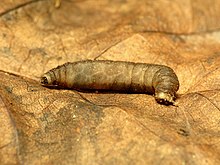| Crane fly Temporal range:
| |
|---|---|

| |
| Nephrotoma appendiculata (spotted crane fly) | |

| |
| Crane fly larva | |
| Scientific classification | |
| Domain: | Eukaryota |
| Kingdom: | Animalia |
| Phylum: | Arthropoda |
| Class: | Insecta |
| Order: | Diptera |
| Infraorder: | Tipulomorpha |
| Superfamily: | Tipuloidea Latreille, 1802 |
| Families | |
| |
A crane fly is any member of the dipteran superfamily Tipuloidea, which contains the living families Cylindrotomidae, Limoniidae, Pediciidae and Tipulidae, as well as several extinct families. "Winter crane flies", members of the family Trichoceridae, are sufficiently different from the typical crane flies of Tipuloidea to be excluded from the superfamily Tipuloidea, and are placed as their sister group within Tipulomorpha.
The classification of crane flies has been varied in the past, with some or all of these families treated as subfamilies,[1] but the following classification is currently accepted.[2][3][4][5][6] (Species counts are approximate, and vary over time.)[4]
- Infraorder Tipulomorpha
- Superfamily Tipuloidea (Typical Crane Flies)
- Family Cylindrotomidae (Cylindrotomid or Long-Bodied Crane Flies, 67 species)
- Family Limoniidae (Limoniid Crane Flies, 10,786 species, possibly paraphyletic)
- Family Pediciidae (Hairy-eyed Crane Flies, 498 species)
- Family Tipulidae (Large Crane Flies, 4,351 species)
- Family Trichoceridae (Winter Crane Flies)
In colloquial speech, crane flies are known as mosquito hawks or "skeeter-eaters", though they do not actually prey on adult mosquitos or other insects.[7][8] They are also sometimes called "daddy longlegs",[7] a name which is also used for arachnids of the family Pholcidae and the order Opiliones. The larvae of crane flies are known commonly as leatherjackets.[7]
Crane flies first appeared during the Middle Triassic, around 245 million years ago, making them one of the oldest known groups of flies,[9] and are found worldwide, though individual species usually have limited ranges. They are most diverse in the tropics but are also common in northern latitudes and high elevations.[10]
More than 15,500 species and over 500 genera of crane flies have been described, the majority by Charles Paul Alexander, who published descriptions of 10,890 new species and subspecies, and 256 new genera and subgenera over a period of 71 years, from 1910 to 1981.[4][11]
- ^ Cite error: The named reference
Byers1981was invoked but never defined (see the help page). - ^ Cite error: The named reference
Zhang2016was invoked but never defined (see the help page). - ^ Cite error: The named reference
Kolcsár2021was invoked but never defined (see the help page). - ^ a b c Cite error: The named reference
Oosterbroek2023was invoked but never defined (see the help page). - ^ Cite error: The named reference
Zhang2019was invoked but never defined (see the help page). - ^ Cite error: The named reference
bugguidewas invoked but never defined (see the help page). - ^ a b c Cite error: The named reference
deltawas invoked but never defined (see the help page). - ^ "Do Mosquito Hawks Eat Mosquitoes?". endmosquitoes.com. Retrieved 29 August 2019.
- ^ Lukashevich, Elena D.; Ribeiro, Guilherme C. (2019-04-18). "Mesozoic fossils and the phylogeny of Tipulomorpha (Insecta: Diptera)". Journal of Systematic Palaeontology. 17 (8): 635–652. Bibcode:2019JSPal..17..635L. doi:10.1080/14772019.2018.1448899. ISSN 1477-2019.
- ^ Pritchard, G (1983). "Biology of Tipulidae" (PDF). Annual Review of Entomology. 28 (1): 1–22. doi:10.1146/annurev.en.28.010183.000245. Archived from the original (PDF) on 2014-01-12. Retrieved 2013-10-08.
- ^ Cite error: The named reference
oowas invoked but never defined (see the help page).